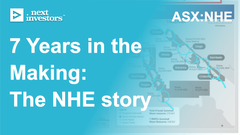A Globally Significant Helium Discovery? Bigger than anyone expected…
Disclosure: S3 Consortium Pty Ltd (the Company) and Associated Entities own 3,980,926 NHE shares and 2,437,037 options, and the Company’s staff own 54,339 NHE shares and 2,000 NHE options at the time of publishing this article. The Company has been engaged by NHE to share our commentary on the progress of our Investment in NHE over time.
The initial results of the drilling are in...
Our Investment Noble Helium (ASX:NHE) has spent seven years working towards drilling two helium wells in a frontier, unexplored basin in Africa.
Helium is a critical input for rapidly growing high tech industries like semiconductors, artificial intelligence chips, nuclear power, space travel and cryogenics.
NHE is chasing potentially the largest helium resource in the world owned by a single company.
NHE has ten similar targets in their North Rukwa basin, with an estimated 176Bcf prospective helium resource.
(176Bcf is enormous by helium standards...)
NHE has just finished drilling two holes into just ONE out of TEN targets.
Only about 9% of the total prospective resource (15.7Bcf).
Which on its own could lead to a company making discovery...
At US$450/mcf and assuming ~75% is recoverable, that’s roughly about US$4.5BN worth of helium in the ground on just ONE out of TEN of NHE’s similar targets.
Because NHE’s other nine targets are all on a similar geological structure and model, success on the first target implies that the other nine similar targets will be successful too.
In oil & gas drilling, this is called a “string of pearls” concept - more on this later.
The preliminary results of two drills into the first target have just been released...
...now it turns out that it could be MUCH BIGGER than what was modelled and expected by NHE.
Mbelele-1 hit net reservoir thickness of 47.5m - 137% bigger than pre-drill expectations.
Mbelele-2 hit net reservoir thickness of 163m - 243% bigger than pre-drill expectations.
AND NHE estimates 2% to 3% helium content in samples taken.
NHE also says the reservoirs are of excellent quality with “good to very good permeability porosity” and “high mobilities”.
Across Mbelele-2 porosity was as high as ~18.4% - typically anything above 10% is considered good...
Reservoir quality can make or break a project - things like porosity/permeability ultimately determine whether or not valuable gas in a reservoir can flow commercially.
NHE is saying its reservoirs “have very high flow potential” AND NHE has already cased and suspended Mbelele-2 as a potential future producer...
So far, the results are based on the company’s wireline logging and sampling program...
Before NHE can officially declare a new “discovery” it has to send its samples to the labs and get them independently confirmed..
Again, if this first target is successful it implies that NHE’s nine other targets will be successful too.
Later today, NHE co-founder & CEO Justyn Wood, and Exec Chairman Shaun Scott and will be presenting at a virtual conference.
We expect to hear more detail on today’s results and next steps for NHE.
The presentation is at 2:50PM AEDT today, Monday 4th December.
It’s open to anyone to join - click this link to register your attendance and watch.
A Globally Significant Helium Discovery?
So far so good...
The helium samples NHE brought to surface have now been sent to independent laboratories for confirmation BEFORE an official “discovery” can be declared.
NHE’s drill results and reservoir thicknesses were so much bigger than expected that the company now needs to:
- remodel their reservoir estimates to accurately reflect the size, and
- run some new reservoir flow modelling based on the bigger numbers...
... before they are able to officially declare a discovery - and have the discovery independently certified by a third party.
So we have a few more weeks to wait for:
- Official and final % helium content from lab analysis... NHE’s estimate of 2% to 3% is already significant for helium concentrations.
- Updated reservoir modelling using the “bigger than expected” reservoir thicknesses from the two wells it has just drilled.
- Updated modelling that reflects the flow potential of the reservoirs intercepted.
Then hopefully if all goes to plan - the official declaration of discovery of a globally significant, primary helium resource.
In mineral exploration terminology - NHE has all the right indicators from the on-site “visual” results... it just needs the assay labs to confirm what it thinks it has found...
NHE says its next step is going to be to run a flow test on Mbelele-2, and that it has already started “positioning for commercialisation” (back in September).
Assuming a commercial discovery, back in September NHE said it can become a helium producer within 12 to 18 months of a discovery at Mbelele.
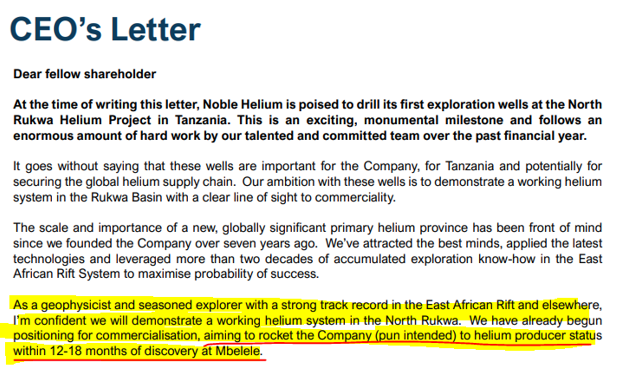
(Source, NHE September 2023 letter front the CEO)
Here is the maths on what commercialisation could look like (assuming a discovery and successful flow test on Mbelele):
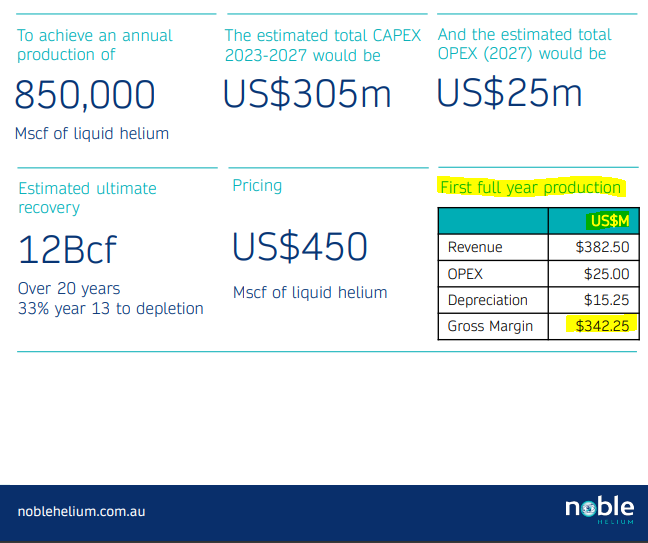
(Source: NHE Presentation)
A few weeks back NHE even mentioned that “discussions with offtakers were underway”...
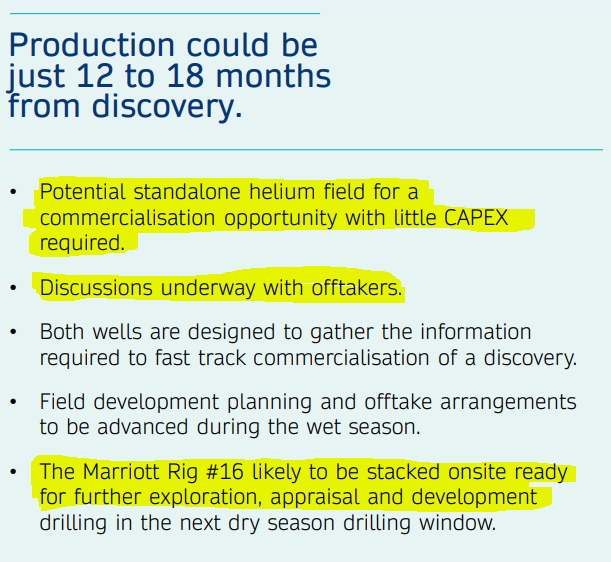
(Source: NHE presentation)
IMPORTANT: String of Pearls - this is all just from ONE out of TEN similar targets NHE has
Earlier we mentioned NHE’s exploration targets were a part of the “string of pearls” concept.
The “string of pearls” theory is where success on the first target implies success on the nine other geologically similiar targets.
NHE’s helium discovery is in the Rukwa basin, Tanzania - part of the giant East African Rift System.
These first two wells in the Mbelele prospect represent 15.7Bcf of a total 176Bcf helium unrisked prospective resource.
To put into perspective just how big this is... if recovered, this would be 1⁄3 of the world’s current helium supply.
NHE’s first two drills were into ONE of TEN similar targets along the “basin margin”, all sharing similar geological and structural properties.
What this means is that IF NHE has made a discovery from the two wells into its FIRST target, then it is highly likely that the other NINE targets have a similar chance of success.
This is known in the industry as a “string of pearls” concept.
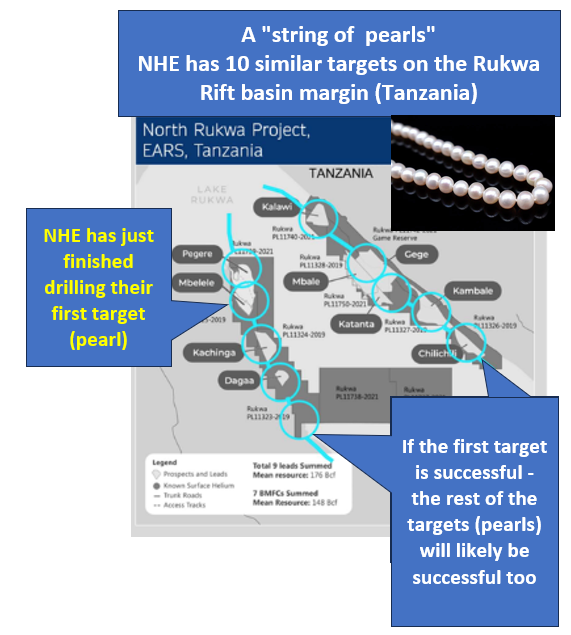
Basin margin “strings of pearls” plays are rare.
Especially undrilled.
Our last Investment that drilled a string of pearls was over 10 years ago when Africa Oil Corp went from $1.50 to $12.50 after successfully declaring a discovery on its first target in their “string of pearls” in Kenya.
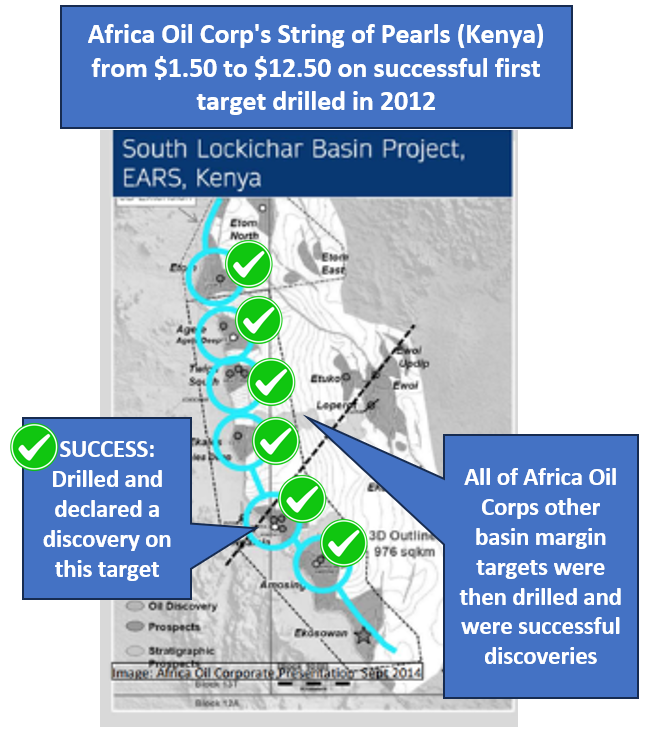
Remember, just because Africa Oil Corp was successful doesn’t mean NHE will do the same, early stage exploration is high risk and many things can and do go wrong.
Both Africa Oil Corp and NHE are in the East African Rift System - a giant, ancient geological structure that spans multiple East African countries and has hosted many resource discoveries over the last 30 years.
NHE co-founder and CEO Justyn Wood is no stranger to success on East African basin margin targets.
He was the exploration geophysicist at Hardman Resources that successfully drilled a “string of pearls” target in Uganda back in 2006 and went from 2c to over $2.
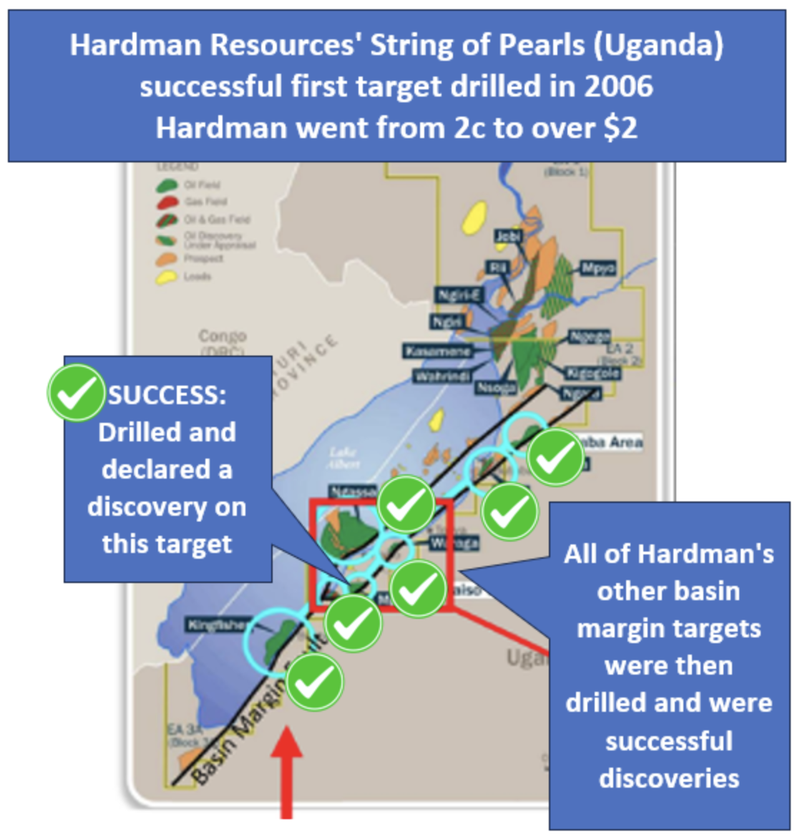
Remember, just because Hardman Resources was successful doesn’t mean NHE will do the same, early stage exploration is high risk and many things can and do go wrong.
This 2006 Hardman Resources discovery was also along a basin margin in the East African Rift System.
Same as the one as Africa Oil Corp successfully drilled in 2012.
Same as the one NHE just drilled.
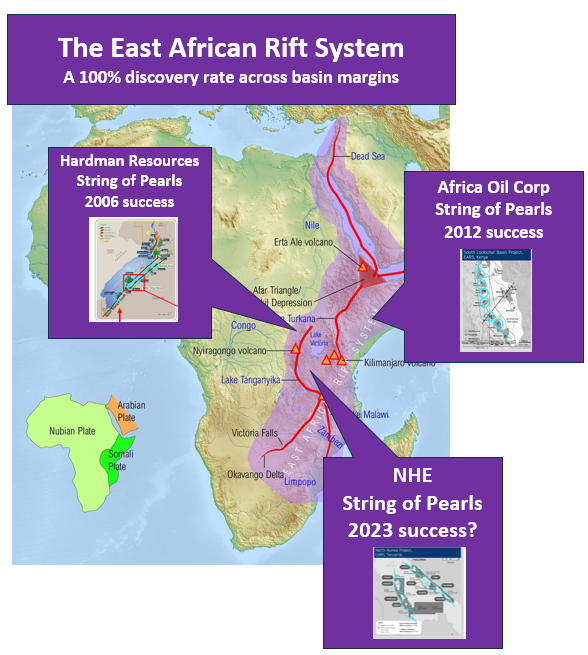
Some of Africa’s biggest oil and gas discoveries have been made across basins in the East African Rift System (EARS).
Nearly 40 exploration wells proved more than 4 billion barrels of oil and gas in two EARS basins - the Albertine Graben in Uganda and South Lokichar Basin in Kenya.
Of the 40 wells drilled ~14 were drilled across Basin Margin Fault Closure targets with a 100% discovery rate - the 14 wells were part of a “string of pearls” system which resulted in a string of discoveries.
NHE’s first two wells (Mbelele-1 and Mbelele-2) both drilled into a basin margin target.
So from a geological perspective the chances are in NHE’s favour.
Going into NHE’s first ever drill program we set the following expectations for NHE:
- Bull case (outstanding result) = NHE finds helium and is able to declare an official discovery.
- Base case (Good result) = NHE finds helium but isn't able to confirm an official discovery yet due to technical reasons.
- Bear case (bad result) = NHE finds no working helium system.
After today’s preliminary results NHE has hit at the very least our “base case” expectation so far...
Now we wait for the lab results to confirm the discovery (fingers crossed) and for NHE to hit our bull case.
NHE’s team has been there and done it all before...
We are backing NHE’s management team to deliver on our Bull case for this drilling programme.
(But we also have identified and accepted the risks associated with high risk frontier oil & gas drilling like this, listed at the end of this note.)
NHE co-founder and CEO Justyn Wood has been working on NHE for 7 years now, and holds over 70 million NHE shares, or ~19.5% of NHE.
During the last 7 years, NHE snapped up all the best land along the Rukwa basin margin for helium exploration.
Justyn knows how to make basin margin discoveries and has a LOT of skin in the game.
Justyn was the technical geophysicist for Hardman Resources, designing the first seismic survey and exploration program over its East African Rift System project in Uganda.
Hardman went from 2 cents to over $2, pushed along by the first oil discovery in the East African Rift System (EARS) and eventually was bought out by 50% JV partner Tullow Oil in 2007 for ~AU$1.5BN.
NHE’s chairman Shaun Scott also owns 1.82% of the company, he has been investing in placements and lending money to the company over the last few months.
Shaun helped pioneer the Queensland coal seam gas industry from “novelty” status to a $20 billion per year export industry.
He was the CEO of Arrow Energy Ltd and led the growth of that business from a $20M coal seam gas explorer until its $3.5BN acquisition by Shell and Petro-China.
He is effectively the “Father of the coal seam gas industry" in Queensland.
Shaun stumped up a cool $1M in the June NHE cap raise at 18c and a further $1.5M along with non-executive director Greg Collumbus in an unsecured VAT loan agreement to NHE a few days ago (full terms here).
Shaun has put his money where his mouth is and appears to be a true believer in the NHE story...
(again) Later today, NHE co-founder & CEO Justyn Wood, and Exec Chairman Shaun Scott and will be presenting at a virtual conference.
We expect to hear more detail on today’s results and next steps for NHE.
The presentation is at 2:50PM AEDT today, Monday 4th December.
It’s open to anyone to join - click this link to register your attendance and watch.
NHE is currently capped at ~$66M (undiluted) - and trades at around ~18.5c per share.
We currently hold 3,980,926 NHE shares and 2,437,037 NHE options.
So it’s going to be an exciting time for us as NHE Investors as we wait for the final independent lab analysis and hopefully for NHE to officially declare the discovery of a globally significant helium resource.
And then the first flow test and hopefully commercialisation in 12 to 18 months.
It’s probably even more exciting for NHE’s CEO Justyn with his 70 million NHE shares...
An MST Access research note published in August placed a 79c per share valuation on NHE, and if they get into production $3.60 per share on an unrisked basis:
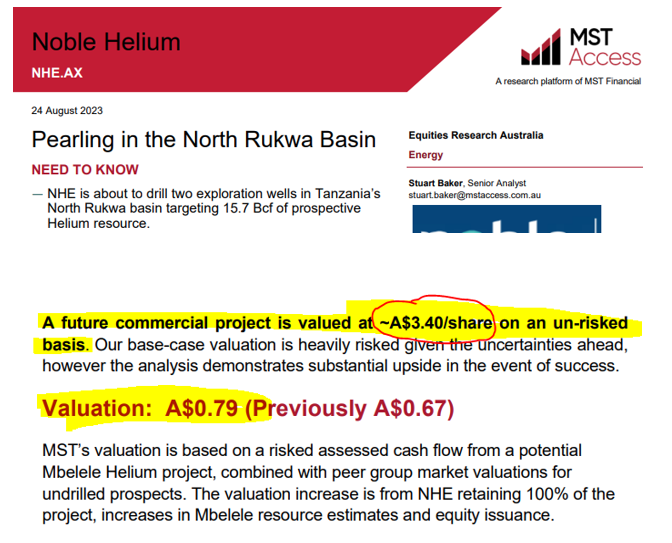
(Source - Read the full August 2023 MST NHE research report here)
While that price target does look interesting, we should be clear that analyst price targets are based on a number of assumptions that may be incorrect - they (or us) don't have a crystal ball. It’s definitely possible NHE does not reach these share prices. This is high risk exploration. Never invest on a price target alone, and always do your own research
Our NHE “Big Bet”
“NHE discovers the world’s largest helium reserve held by a single company and is strategically acquired by a major company OR a state owned enterprise to secure supply (USA, China, Qatar)”
(NOTE: This is what we hope the ultimate success scenario looks like for this particular Investment over the long term (3+ years). There is a lot of work to be done by the company to get to this outcome and obvious risks to which need to be considered, some of which we list in our NHE Investment memo).
In terms of how our Big Bet could become a reality, here are some current major helium suppliers that might be interested in securing a significant resource:
- Exxon Mobil
- Air Liquide
- Qatargas
- Gazprom
- Linde Plc
We also think a large proven helium resource would be of strategic importance to nations like the US and China - to secure national helium supply as it is a key ingredient in semiconductor production.
Or it could also be of interest to Qatar - a nation that is already a major helium supplier and might want to add to its resources.
There is a lot of work still to be done, but now with these positive results published today and the company on the cusp of a discovery, NHE will look to prove up its resource and start selling its helium to the biggest buyer.
In the rest of today’s note
- Quick summary on helium and what it is used for
- Strings of Pearls - found in the East African Rift System
- String of Pearls History: Our first 10 bagger back in 2012- What a previous successful drill campaign looks like
- String of Pearls History: Success at Hardman Resources - 2c to over $2
- East African Rift Basin Land Grab - NHE snapped up all the best ground
- NHE: Getting the Hardman Resources band back together
- What’s next for NHE?
- What are the risks?
Quick summary on helium and what it is used for
Computer chips, and other emerging high-tech industries are reliant on helium.
We’re particularly interested in helium’s use as a key ingredient in the production of microchips and semiconductors.
Helium is a unique type of gas because it is ‘inert’ - meaning it doesn't react with other chemical elements
The price of helium has been growing, with some contracts valuing the gas at ~US$1,100 (including the Air Products 5-year supply deal with NASA).
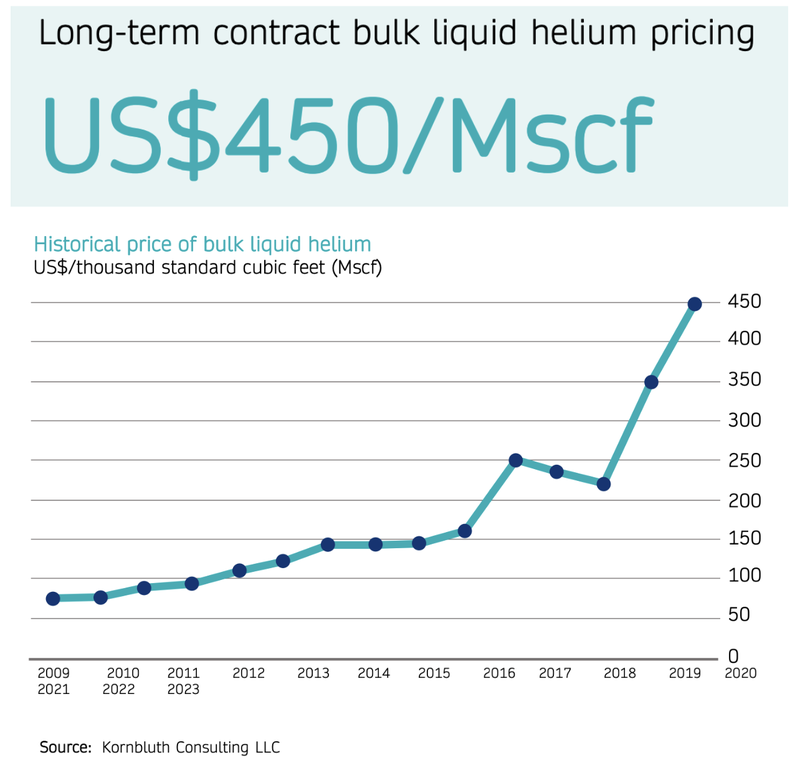
(Source)
Use of helium is expected to increase in rapidly expanding high tech industries like semiconductors, aerospace, fibre optics and cryogenics:
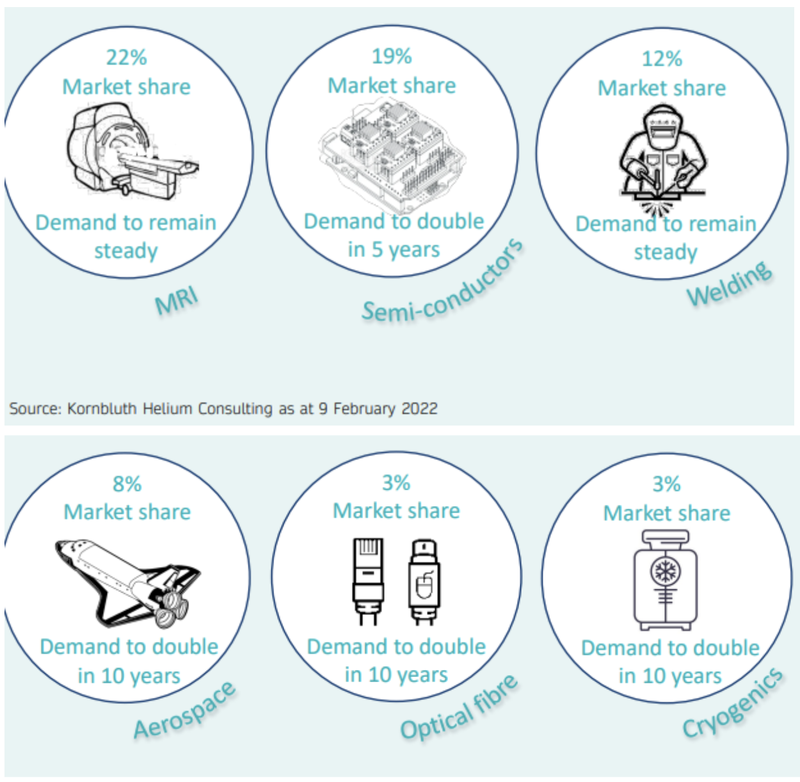
For the best part of a century, the US has been the world's biggest supplier of helium.
But over the last few decades, helium supply dominance has slowly shifted to countries like Qatar and Russia.
The US government is about to exit from the helium industry altogether, as it is looking to sell off its federal helium reserve:

(Source)
After the Russia/Ukraine war broke out, the global helium supply chain was hit even harder and subsequently helium prices have gone on a run, despite being a relatively opaque market.
For eight of the last ~17 years the helium supply chain has been one of the most fragile in the world, experiencing shortages on a regular basis.
At the same time, helium is an important input into some industries we take for granted like MRI’s and semiconductors.
Without helium, the semiconductor supply chain falls apart and MRI machines aren't able to operate.
We think that a resource the size of NHE’s, which if recovered, accounts for 1⁄3 of the current world's helium supply, will be of great interest to nations looking to secure their supply chain of this growingly important element.
Let’s look at some of the key industries driving demand for helium:
Semiconductor manufacture
Semiconductors are used in phones, electric cars, and advanced weapons systems.
Helium is used in the manufacture of these chips because it is an “inert” gas (it doesn’t react with other chemicals used in the chipmaking process), and it is great at cooling things down (chip production creates a lot of heat).
The semiconductor market is dominated by TSMC (based in Taiwan).
The US has made a concerted effort to “on-shore” semiconductor manufacturing through the CHIPS Act, increasing demand for materials critical in the manufacturing process - like helium.
Artificial Intelligence
The demand for semiconductors (microchips) is set to grow in an era of artificial intelligence, where the limitations of AI are set by processing power.
As AI becomes more advanced it needs more and more processing power, and specially designed microchips... which need helium to manufacture.
Space travel
NASA uses helium to keep hot gases and ultra-cold liquid fuel separated during lift-off of rockets.
NASA, released details of a contract that it had signed with US based Air Products and Chemicals (capped at US$63BN).
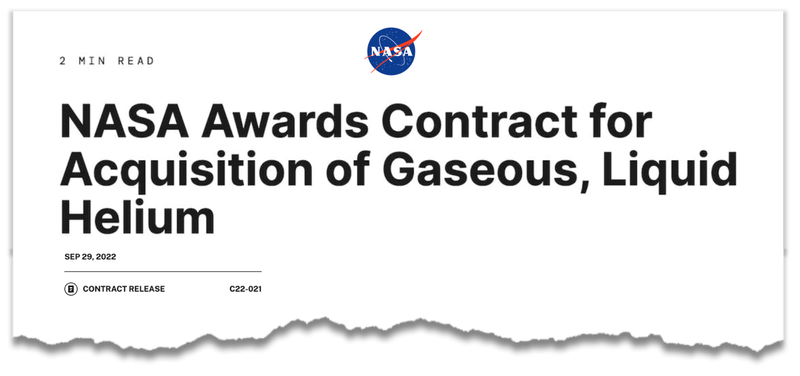
(Source)
That contract was to supply 33 million litres of liquid helium to NASA's Kennedy Space Center for an initial 23 month period, and potentially through to 2027.
The contract could be worth up to US$1.07BN.
Nuclear power
Helium coolant has been used for fission reactors and conceptual fusion power plant designs.
This is due to helium’s cooling properties as an inert gas.
MRI machines
Hospitals are the largest (current) end users of helium, accounting for 22% of the global helium market in 2022.
An MRI unit requires approximately 2,000 litres of liquid helium to keep the magnet cool enough to operate.
Additional refills may be required over the lifetime of the unit to replace helium that boils off and escapes into the atmosphere.
The size of the helium prize NHE chasing: US$5.4B?
NHE’s investor presentation shows a worked example assuming that 12Bcf of that is ultimately recoverable, then at helium price of US $450/mcf we calculate that’s US $5.4B worth of helium in the ground (assuming of course a discovery is made).
This is just for NHE’s first target - NHE’s 9 other targets that contain a further prospective ~160Bcf of helium.
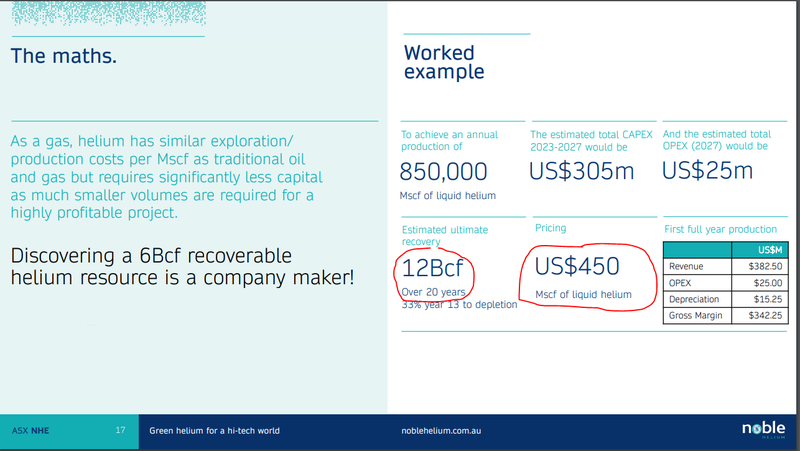
(Source)
🎓To learn more about oil and gas resources and how they are converted from prospective resource into reserves check our our educational article here: How to read oil & gas resources
Then it gets bigger... remember the “string of pearls” - with success on NHE’s first target, the next nine could be successful too...
A key reason we Invested in NHE and why we are backing the company to make a discovery has to do with its project’s location.
NHE’s helium targets has an unrisked prospective resource of ~176 bcf from targets sitting along a basin margin fault closure INSIDE the East African Rift System (EARS).
The “string of pearls” analogy is a concept in oil and gas exploration where one discovery on a target (a “pearl”) in the “string” implies a high chance of success on all other targets (pearls) in the “string”.
This is because each target sits on the same geological structure and is drilled using the same geological thesis - if one works they should ALL work.
Long time readers of the Next Investors blog will know of the East Africa Rift System (EARS) & ‘String Of Pearls’ story.
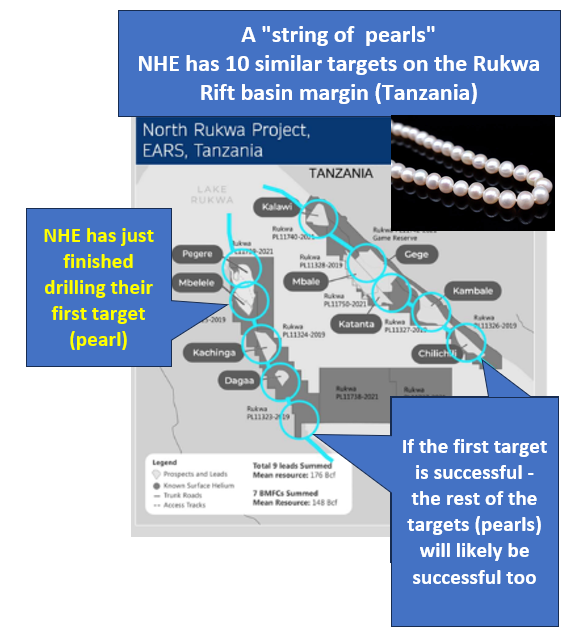
Strings of pearls - found in the East African Rift System
NHE’s project is located in the East African Rift System (EARS), an active continental rift zone in East Africa.
Some of Africa’s biggest oil and gas discoveries have been made across basins in the East African Rift System (EARS).
Nearly 40 exploration wells proved more than 4 billion barrels of oil and gas in two EARS basins - the Albertine Graben in Uganda and South Lokichar Basin in Kenya.
Of the 40 wells drilled ~14 were drilled across Basin Margin Fault Closure targets with a 100% discovery rate - the 14 wells were part of a “string of pearls” system which resulted in a string of discoveries.
NHE’s first two wells (Mbelele-1 and Mbelele-2) are both basin margin targets.
So from a geological perspective the chances are in NHE’s favour.
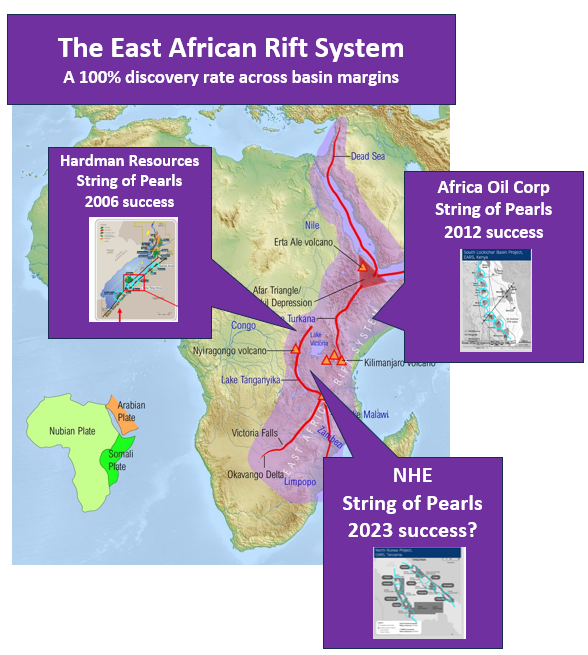
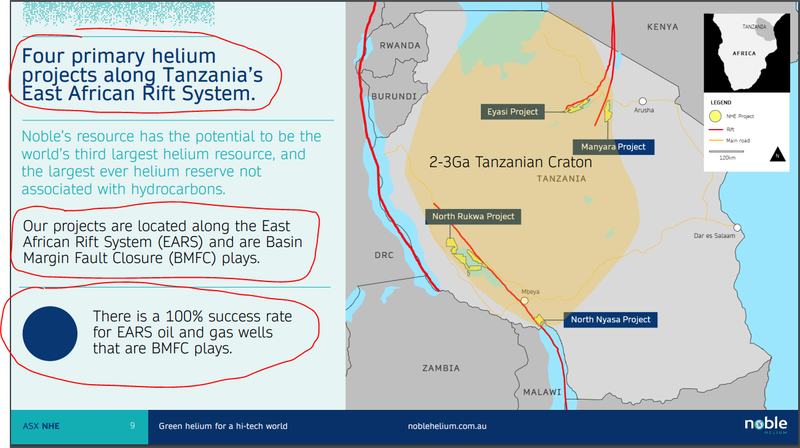
(Source)
String of Pearls History: Our first 10 bagger back in 2012- What a previous successful drill campaign looks like
As mentioned earlier, an analogue for exploration success on basin margin targets inside the East African Rift System is Africa Oil Corp between 2011 and 2013.
At the time, Africa Oil Corp also had a basin margin string of pearls in the East African Rift System, where one target drilled successfully would imply that the rest of the targets would likely be successful too.
Africa Oil Corp’s share price went from $1.50 to $12.50 over a few months in the lead up to and then into the company’s first discovery.
Note: an obvious difference between NHE and Africa Oil is that NHE is going for helium while Africa Oil was going for oil & gas, which is a much bigger market and a lot better understood by investors. This is just a case study of an explorer with a similar exploration target that had exploration success.
Here is what the Africa Oil Corp share price looked like from 2011 to 2013, which includes:
- Pre-drill work leading up to the first well
- A multi zone discovery on the first well that drove up the share price
- And then subsequent drilling and other key announcements
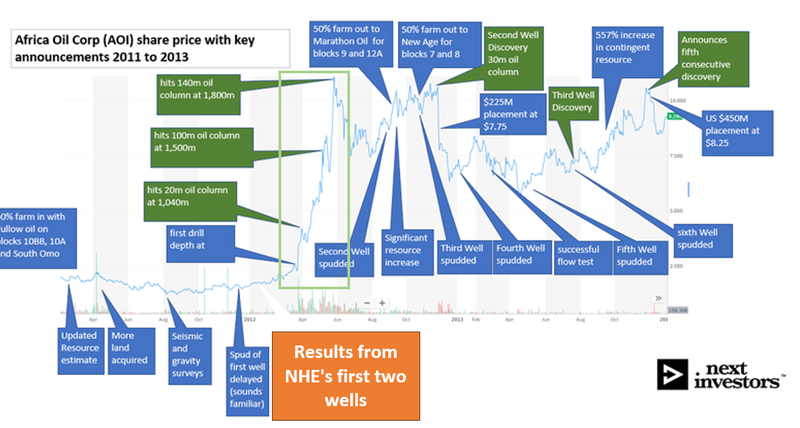
Remember, just because Africa Oil Corp performed this way doesn’t mean NHE will do the same, early stage exploration is high risk and many things can and do go wrong.
Like NHE, Africa Oil’s share price traded sideways/down leading up to the drill program as the company increased its resource estimates and got ready to drill its first well.
Then as Africa Oil started drilling the share price started moving higher and the big moves started after the well hit Total Depth (TD).
The three big moves (totaling ~1,000%) happened over a period of ~3 months where Africa Oil announced discoveries across multiple different reservoir units.
So it wasn’t a single announcement, it wasn’t a drilling update but it was the updates the company put out as results from the well started to come in that really got the share price moving.
After that first Africa Oil Corp discovery and a ~1,000% move in its share price Africa Oil drilled five wells back to back.
Three of those wells (on the basin margin) could be new discoveries and Africa Oil raised ~US$675M off the back of the drill programs.
(unlike Africa Oil Corp, NHE says their plan is to fast track commercialisation over 12 to 18 months, which would hopefully lead to early cashflows to fund drilling the rest of it’s string of pearls)
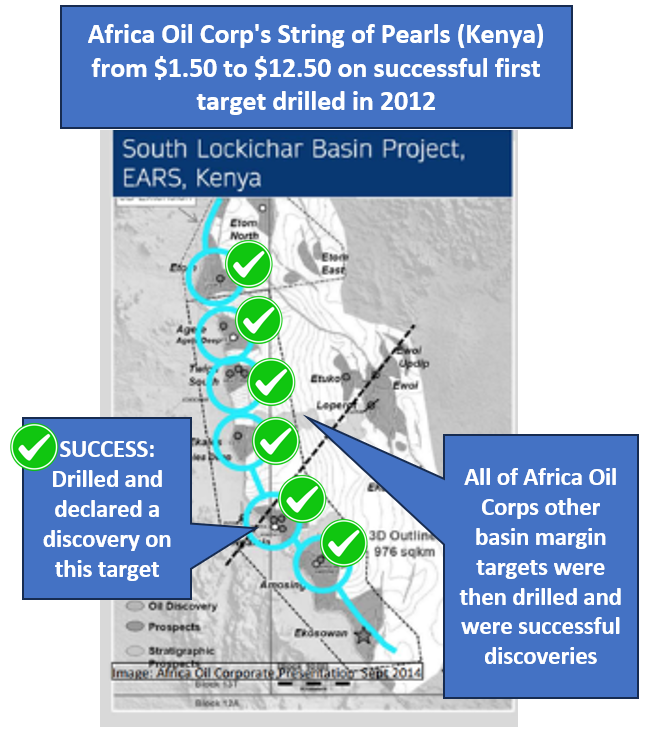
NHE could still choose to go on and drill its remaining basin margin targets especially given its only drilled less than 10% of the company’s total prospective resource.
NHE has nine other similar targets along the basin margin fault where it has secured all its land.
In total NHE has four different projects and a total unrisked prospective resource of 176 Bcf.
The first and second well (Mbelele-1 and Mbelele-2) both drilled into a 15.7 bcf prospective resource.
Similarly to Africa Oil Corp, NHE will have many more exploration targets to follow up with IF it declares a discovery on its first Mbelele target.
The bonus is that NHE also owns 100% of the ground along its basin margin so the company will also have the keys to the projects if any potential partners start sniffing around.
(Africa Oil Corp had farmed out much of its ownership prior to its drilling)
We had referenced this before in an old IVZ note, but here it is again...
How did the Africa Oil Corp share price respond as each announcement came out during its drilling of its own “string of pearls”
All of the announcements for Africa Oil that happened between 2011 and 2013 including the three announcements after the first well was spudded which led to that ~1,000% move for us in its share price (we had invested well before drilling at sub $1).
First spud was on the 16th of January 2012 and it took almost ~4 months until the discovery was first announced.
The oil discovery announcement came on the 26th of March 2012 and then the two following announcements almost two months later in May.
- 2012 Jan 16 [share price $1.49] - First well in string of pearls spudded
- 2012 Mar 26 [share price $3.35] - Oil discovery 20m oil column at 1040m drilling to continue
- 2012 May 07 [share price $7.82] - More oil discovered at 1500m, oil column in excess of 100m
- 2012 May 25 [share price $9.94] - Another 140m of oil from 1800m to 1940m
We renamed the announcements in the following format:
[YYYY MM DD] [share price at end of day] [Announcement Summary]
You can access the announcements here.
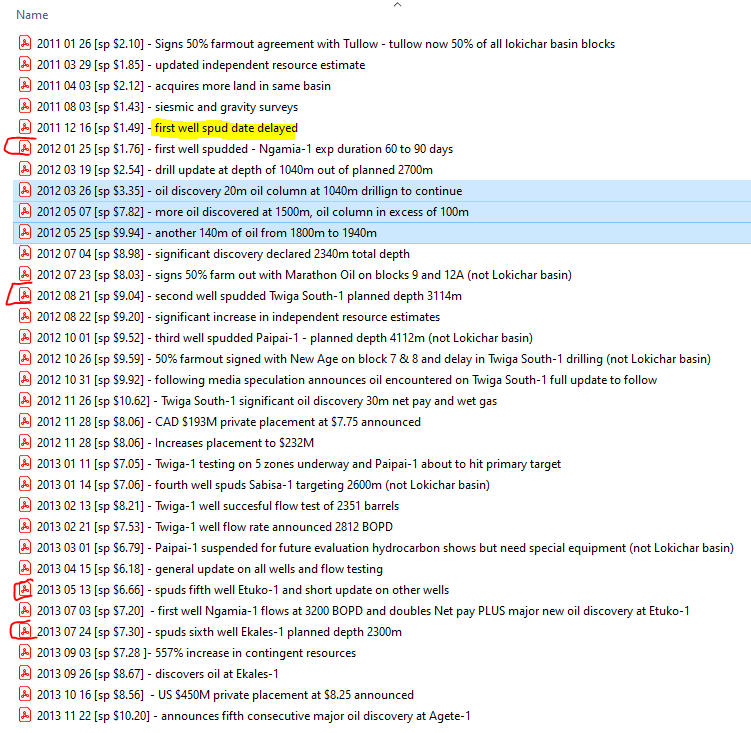
String of Pearls History: Success at Hardman Resources - 2c to over $2
We are hoping that NHE’s exploration team can follow on from some of the most successful exploration in Africa, including Hardman Resources.
Back in 2006, the CEO of NHE, Justyn Wood, was working as an exploration geophysicist at Hardman Resources.
Most small cap investors over the age of 30 will remember Hardman as one of the great small cap success stories of the 2000s.
Justyn was the technical geophysicist at the time, designing the first seismic survey and exploration program over Hardman’s East African Rift System project area in Uganda.
Hardman went from 2 cents to over $2, pushed along by the first oil discovery in the East African Rift System (EARS) and eventually bought out by 50% JV partner Tullow Oil in 2007 for ~AU$1.5 billion.
14 years later, Justyn is looking to repeat this success with NHE through a helium discovery in the East African Rift System in Tanzania.
After 7 years of preparation, months of seismic and target generation work, NHE has just announced the preliminary results from two wells into its first target, Mbelele.
We have been Invested in NHE for over two years (first at the pre-IPO stage) and followed NHE as it listed on the ASX in 2022 and has progressed towards and completed its first drill campaign.
Now we have just a few weeks to wait before independent lab results hopefully confirm a discovery on NHE”s first “pearl”
Justyn’s Hardman discovery in 2006 was in the East African Rift System and made famous the “string of pearls” concept.
Again, the string of pearls analogy is a concept in oil and gas exploration where one discovery on a target (a “pearl”) in the “string” implies a high chance of success on all other targets in the “string”.

Justyn was the exploration geophysicist and Key Project Proponent at Hardman Resources.
Justyn designed and interpreted the first ever seismic survey over Lake Albert in Uganda, designed a two well drill program and led the Hardman team to the company’s first two wells in the basin back in 2006.
In 2006 one of Hardman’s wells flowed ~12,000 barrels of oil per day from 3 zones and was effectively the play opener across the entire East African Rift System (EARS).
But the EARS story started a long time before that...
Hardman held ground in Uganda back in 1997 but eventually relinquished its ground in 1999 due to low oil prices.
On the 8th of October 2001 Hardman signed a Production Sharing Agreement ("PSA") with the Government of Uganda for a ~4,700sqkm block in the northern part of Lake Albert in north-western Uganda.
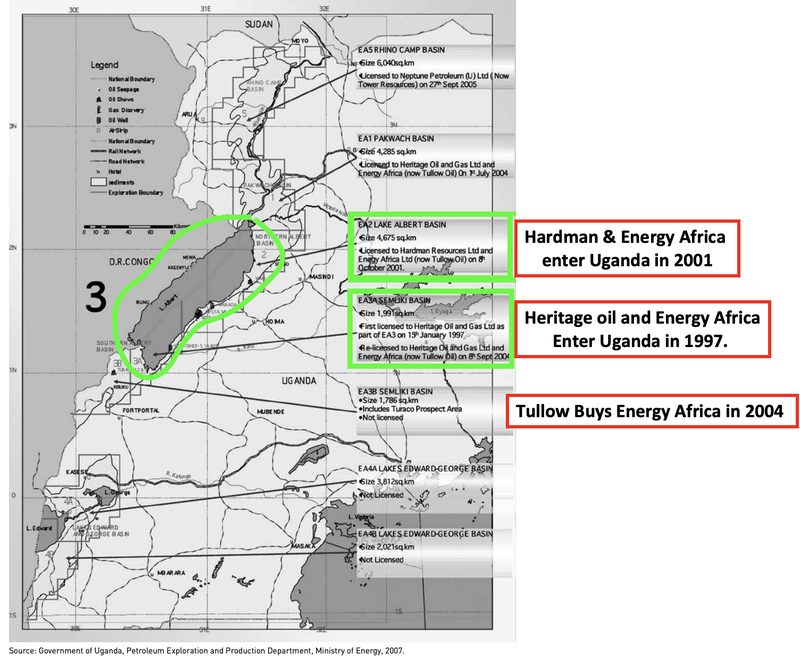
Hardman had a 50-50 joint venture over the block with Energy Africa.
Energy Africa had already moved into the basin ahead of Hardman and was the 50% partner with another company (Heritage Oil and Gas) in the southern part of the Lake Albert area.
At the time only one well had been drilled across the Lake Albert area - a well by Shell in 1938 which returned oil shows.
Hardman’s work in Uganda started with 2D seismic surveys and as the merits of the project became clearer (well before any drilling was done) Tullow swooped in and bought Energy Africa for $500M.
Just like that after spending a few billion dollars Tullow became the main player in the EARS system in Uganda.

In 2006 Hardman drilled its first two wells and made its discovery.
Six months after Hardman’s play opening discovery Tullow acquired the junior for ~$1.47Bn.
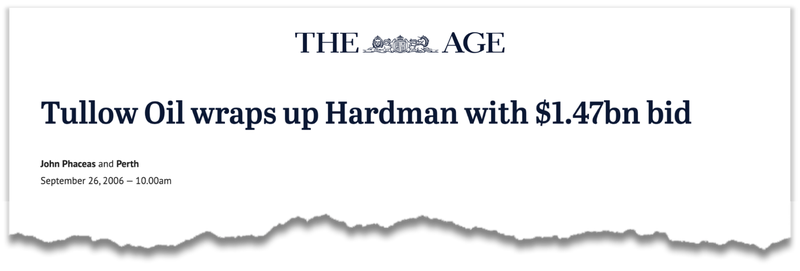
Fast forward to now, more than 6 billion barrels (2C) have been discovered to date in the East African Rift System.
The exploration success rate across the EARS was ~80%.
Nearly 40 exploration wells proved more than 4 billion barrels of oil and gas in two EARS basins - the Albertine Graben, Uganda (Hardman Resources) and South Lokichar Basin, Kenya (Africa Oil Corp).
Of the 40 wells drilled ~14 were drilled across Basin Margin targets with a 100% discovery rate - the 14 wells were part of a “string of pearls” system which resulted in a string of discoveries.
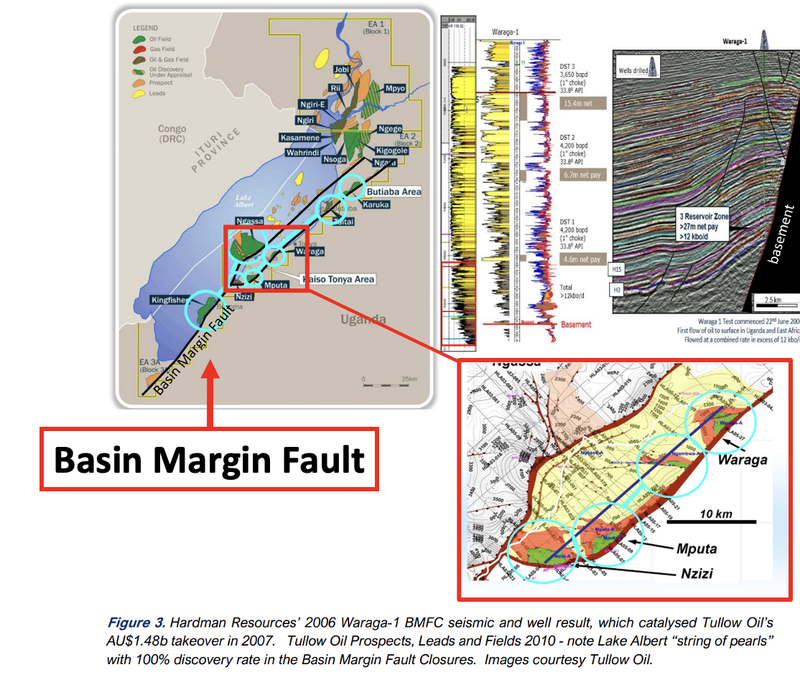
NHE’s helium project sits inside the EARS but is also sitting on the Basin Margin.
Essentially, NHE has its own “string of pearls” which hosts ~138Bcf of its project's total 176Bcf unrisked prospective resource.
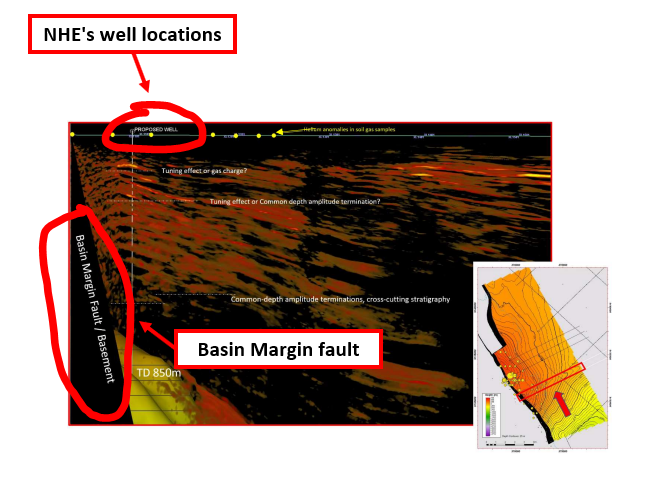
Both of NHE’s first two wells (Mbelele-1 and Mbelele-2) were into a basin margin target.
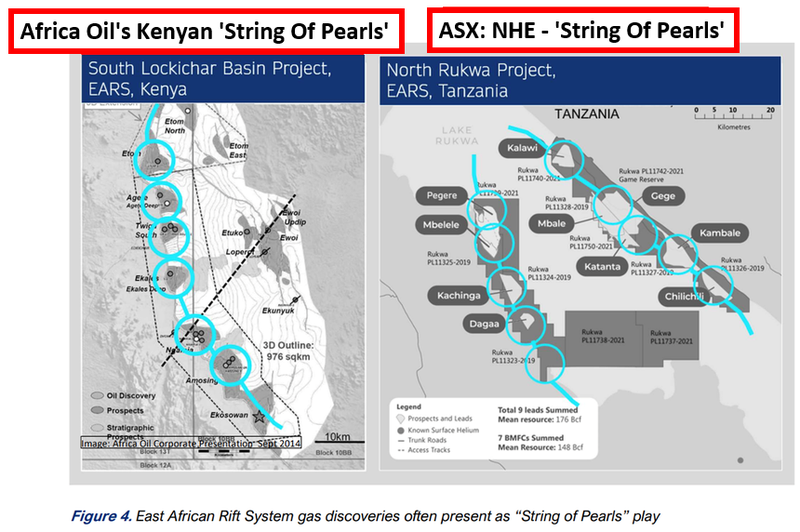
Ultimately we are hoping NHE’s drill program acts as the play opener for NHE’s own string of helium pearls.
If NHE is successful, just like Hardman became a takeover target from a major producer, we hope to see NHE become the prime takeover exposure for any of the majors around the world looking for helium exposure.
East African Rift Basin Land Grab - NHE snapped up all the best ground
Hardman Resources only had a small land holding in the EARS when they made their first “string of pearls” discovery...
Hardman’s first discovery triggered a land grab on all EARS oil exploration permits with similar structural characteristics.
Hardman had left potentially billions of $ on the table by NOT securing all the best, similar land BEFORE testing (and proving) their EARS “string of pearls” hypothesis.
The companies that swooped in and took all the other EARS permits included Tullow Oil, Heritage Oil and Africa Oil Corp.
We invested in Africa Oil Corp around the time they started scooping up all the other “string of pearls” plays in the northern part of the East African Rift System (sorry Hardman, you snooze you lose).
Africa Oil Corp ended up being our best investment of that particular decade after they made a discovery on their first drill (share price rose from ~$1.50 to touch $12.50) - so naturally we are very keen on the “string of pearls” concept in the East African Rift System.
Fast forward to 2023, NHE isn’t making the same mistake with their East African Rift system “string of pearls” hypothesis on helium.
NHE has made sure that this time it holds all of the prospective land across Tanzania’s North Rukwa Basin in anticipation that its hypothesis is correct.
Prior to testing its hypothesis that the EARS contains helium in a “string of pearls”, NHE has secured all the most prospective land just in case they make a discovery and prove the hypothesis.
This is to get ahead of a similar land grab that happened over 10 years ago post the Hardman discovery
Like Africa Oil did back in the 2000’s, NHE has the permits to ALL the best land in the system:
Now all we have to do is wait for the final independent lab analysis plus remodelling, and hope that NHE delivers a commercial helium discovery and proves its EARS helium hypothesis.
If NHE can deliver this first discovery, all the other prospective land they have secured should suddenly become way more valuable under the “string of pearls” model where a successful drill result implies a higher chance of success on all other similar rift basin margin fault targets.
Now we wait... hopefully just a few more weeks.
NHE: Getting the Hardman Resources band back together
When Hardman Resources made the first East African Rift basin discovery in Uganda, NHE founder/CEO Justyn Wood was the Exploration Geophysicist for that discovery.
As a result, we think Justyn is the ideal leader for NHE and expect him to be deeply involved in the interpretation of the 3D seismic, and the accompanying gradiometry and soil sampling.
He is certainly aligned with shareholders, maintaining a stake of 19.5% in NHE on an undiluted basis.
But despite all of this, we must stress that oil & gas exploration is risky and NHE has no guarantees of making a helium discovery. Exploration risk forms a key part of our risks section.
Back in November 2022, Hardman Resources Drilling manager Dermot O’Keeffe joined NHE
The fact that NHE has a highly experienced drill manager onboard is a significant win.
Not only that, but O’Keeffe has a long history with CEO Justyn Wood that stretches all the way back to when the two opened up the Albertine Rift Basin in western Uganda, making the first two oil discoveries for Hardman Resources in 2006.
Yes, basin margin targets on “string of pearls” discoveries in the East African Rift System.
Hardman Resources was subsequently bought out by its Ugandan JV partner Tullow Oil in 2007 for A$1.5BN.
As long-term Investors in NHE, it’s good to know that the Wood and O’Keeffe team has delivered significant value before.
Perhaps more importantly, NHE’s management team are intimately familiar with the “play type” that the company is working with - a Basin Margin Fault Closure (BMFC).
After Tullow acquired Hardman, Tullow drilled 32 more exploration wells in Uganda and Kenya, with a remarkable success rate of 80%.
That success rate was even higher (100%), when Tullow was drilling a Basin Margin Fault Closure.
This is what a Basin Margin Fault Closure looks like:
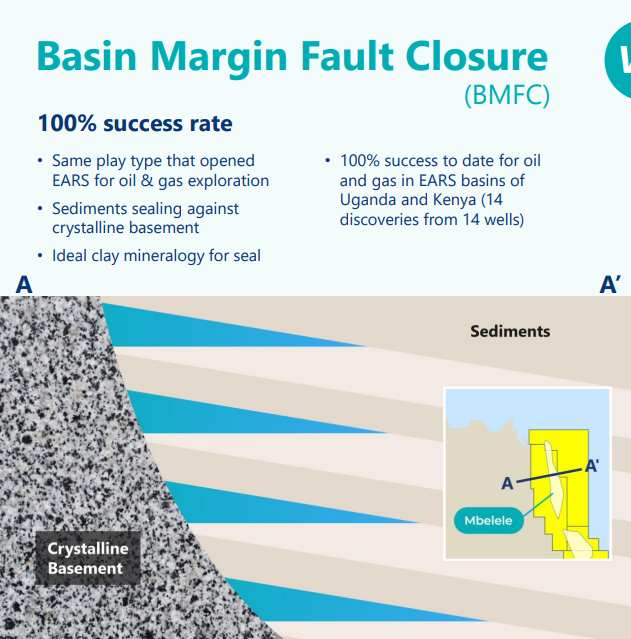
As we understand it, the reason this type of play is so successful is that the geology helps form the perfect seal for gas underneath the earth’s surface.
Helium naturally wants to escape the earth's surface into the atmosphere so the better the seal, the higher the chance of success.
Now for a stroll down memory lane...
We dug up the 3D seismic image that Justyn and Dermot were working with at Hardman was for its breakthrough Mputa-1 discovery - which clearly shows the contours of the basement:
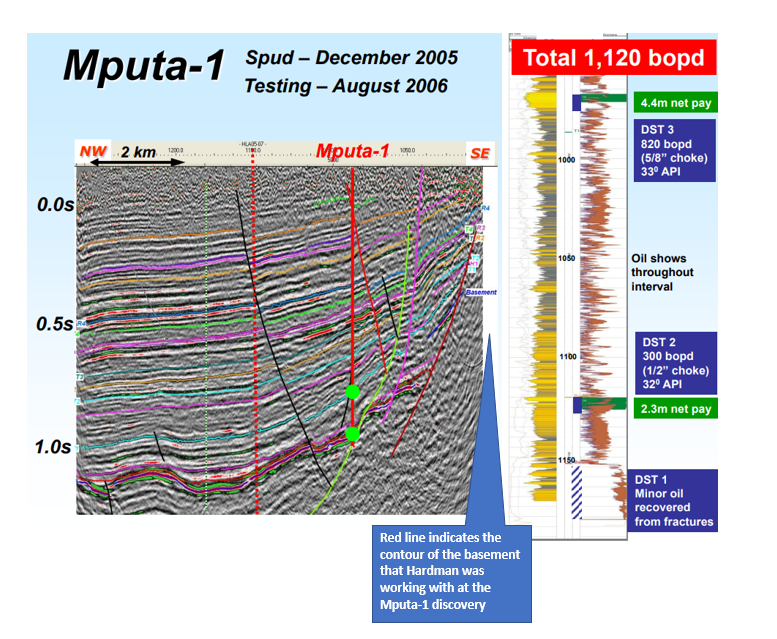
Now with both Dermot and Justyn at NHE, it is exactly the same type of East African Rift System, basin margin targets they are both so familiar with.
Hardman Resource’s Mputa-1 discovery was located just on the the edge of Lake Albert in Uganda as seen below:
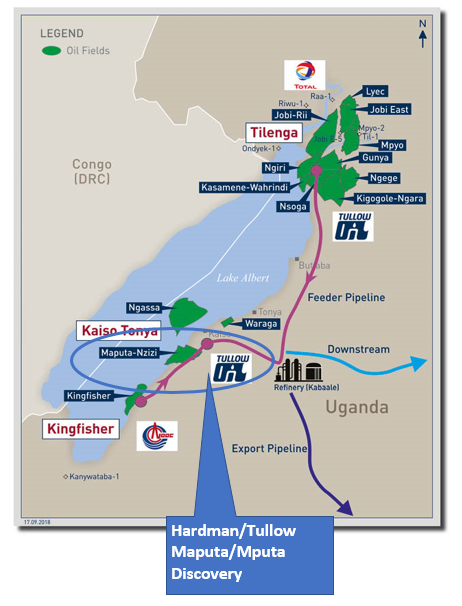
This looks remarkably similar to the targets that NHE is acquiring/has acquired seismic for on the edge of Lake Rukwa in Tanzania:
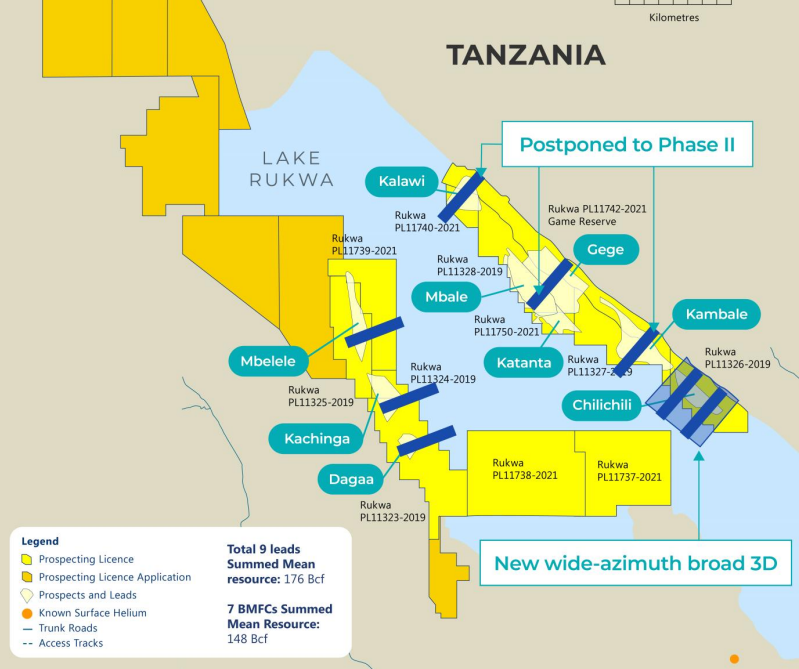
Again... the NHE team knows the East African Rift System extremely well, and have extensive prior experience with Basin Margin Fault Closure plays.
But while this all sounds highly promising for NHE’s drill program, it is important to note that various risks can still materialise, especially exploration risk.
You can have the right drill manager, the right exploration geophysicist as Managing Director, and the perfect location selected by the foremost helium experts in the world, but this is frontier oil & gas exploration and things can still go wrong.
We list some of these risks in our NHE Investment Memo.
NHE Management - skin in the game
Back in June NHE raised $13.5M at 18c, with NHE directors investing over $1M of their own cash.
We like it when company management and board put their money where their mouths are, and be major holders of company shares, as they are aligned with all other shareholders.
This is the case with NHE’s Managing Director Justyn Wood being a top shareholder of NHE - Justyn holds 19.50% of the company’s shares as per the last NHE annual report.
NHE’s chairman Shaun Scott also owns 1.82% of the company, he has been investing in placements and lending money to the company over the last few months.
Shaun helped pioneer the Queensland coal seam gas industry from “novelty” status to a $20 billion per year export industry.
He was the CEO of Arrow Energy Ltd and led the growth of that business from a $20M coal seam gas explorer until its $3.5BN acquisition by Shell and Petro-China.
He is effectively the “Father of the coal seam gas industry" in Queensland.
Shaun stumped up a cool $1M in the June NHE cap raise at 18c and a further $1.5M along with non-executive director Greg Collumbus in an unsecured VAT loan agreement to NHE a few days ago (full terms here).
Shaun has put his money where his mouth is and appears to be a true believer in the NHE story...
Here’s NHE chairman Shaun Scott’s latest purchase of NHE shares:
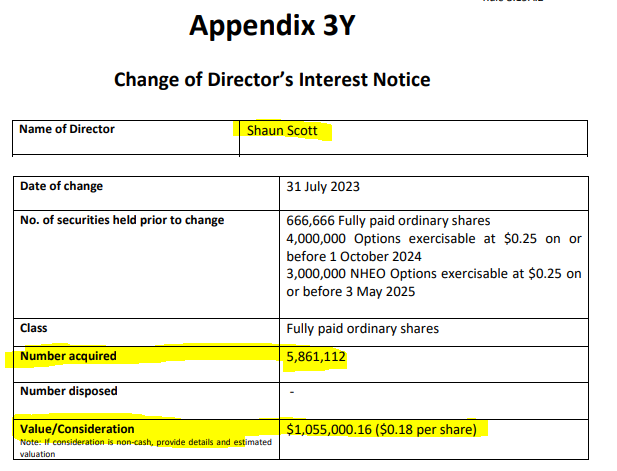
So what is next for NHE?
⚠️The Big One: “Discovery Announced” ⚠️
In a few weeks time we will know whether or not NHE has met the SPE-PRMS standards to declare a discovery.
With helium found, NHE has already hit our “base case” expectations for the program.
- Bull case (outstanding result) = NHE finds helium and is able to declare an official discovery.
- Base case (Good result) = NHE finds helium but isn't able to confirm an official discovery yet due to technical reasons.
- Bear case (bad result) = NHE finds no working helium system.
Lab Results
In a few weeks time we expect to see lab results confirm the preliminary results announced today.
Things like the % helium content across the two wells and final numbers on reservoir thickness’.
Think of these like an “assay result”.
It will provide irrefutable proof that NHE’s project contains a certain % of helium, and the company will be able to update its resource based on this information.
Flow tests on Mbele-2
NHE announced today that it has cased and suspended Mbelele-2 and “planning is now underway to move as quickly as possible” to flow test the well.
Commercialisation progress
If an official discovery is declared we expect to see NHE move quickly to start commercialising its helium resource.
There are certain commercialisation milestones including feasibility studies to confirm CAPEX and OPEX figures and signing offtake contracts for helium supply.
Drill another “pearl”
We also want to see NHE continue to prove its resource by drilling another pearl in the string - adding further evidence to the “string of pearl” theory that defines this giant resource.
What are the risks?
The key risk for NHE is still “Exploration Risk”.
There is always a chance NHE that a discovery is NOT declared and in that scenario we think NHE’s share price could re-rate lower.
Exploration risk
NHE may fail to find and extract commercial quantities of helium despite having promising results so far. We will find out in the flow test and appraisal well that is happening next.
Funding Risk
NHE ended the September quarter with $8.1M in cash in the bank.
Since then, the company secured an additional $4.35M via a unsecured loan related to outstanding VAT payments.
This included $1.5M lent from Executive Chairman Sean Scott and non-Executive Director Greg Columbus. This caused no dilution to existing NHE investors.Now that drilling is complete, and final results are incoming, next we want to see what the 2024 work programme looks like.
The amount of funding required will depend on this work programme.
We hope with all results in hand after two successful wells, that share price appreciation will allow the company to look to raise capital at progressively higher prices, to minimise dilution on existing shareholders (including the company’s board)..
Underlying commodity risk
Helium prices may fall as additional supply comes on line, forcing down prices and reducing investor appetite for new helium resources.
Country risk
Tanzania is an emerging resource jurisdiction and although a change in government has improved the ability to invest in Tanzania, local politics, changes to mining regulations and royalty systems may be a factor in NHE’s future prospects.
Operational risk
Aside from the standard operational risks when drilling in frontier locations, Tanzania has a wet season that stops drilling operations. NHE must initiate and complete operational milestones within the windows between wet seasons.
If NHE fails to complete an operational milestone in the available “non-wet season” windows it could add material delays in waiting for the next window.
Weather is a factor in NHE’s prospects.
To see all of the risks that we listed in our NHE Investment Memo check out the following:
Our NHE Investment Memo
Click here for our NHE Investment Memo, where you can find a short, high level summary of our reasons for Investing.
In our NHE Investment Memo, you’ll find:
- Key objectives for NHE
- Why we are Invested in NHE
- What the key risks to our investment thesis are
- Our investment plan
General Information Only
S3 Consortium Pty Ltd (S3, ‘we’, ‘us’, ‘our’) (CAR No. 433913) is a corporate authorised representative of LeMessurier Securities Pty Ltd (AFSL No. 296877). The information contained in this article is general information and is for informational purposes only. Any advice is general advice only. Any advice contained in this article does not constitute personal advice and S3 has not taken into consideration your personal objectives, financial situation or needs. Please seek your own independent professional advice before making any financial investment decision. Those persons acting upon information contained in this article do so entirely at their own risk.
Conflicts of Interest Notice
S3 and its associated entities may hold investments in companies featured in its articles, including through being paid in the securities of the companies we provide commentary on. We disclose the securities held in relation to a particular company that we provide commentary on. Refer to our Disclosure Policy for information on our self-imposed trading blackouts, hold conditions and de-risking (sell conditions) which seek to mitigate against any potential conflicts of interest.
Publication Notice and Disclaimer
The information contained in this article is current as at the publication date. At the time of publishing, the information contained in this article is based on sources which are available in the public domain that we consider to be reliable, and our own analysis of those sources. The views of the author may not reflect the views of the AFSL holder. Any decision by you to purchase securities in the companies featured in this article should be done so after you have sought your own independent professional advice regarding this information and made your own inquiries as to the validity of any information in this article.
Any forward-looking statements contained in this article are not guarantees or predictions of future performance, and involve known and unknown risks, uncertainties and other factors, many of which are beyond our control, and which may cause actual results or performance of companies featured to differ materially from those expressed in the statements contained in this article. S3 cannot and does not give any assurance that the results or performance expressed or implied by any forward-looking statements contained in this article will actually occur and readers are cautioned not to put undue reliance on forward-looking statements.
This article may include references to our past investing performance. Past performance is not a reliable indicator of our future investing performance.




